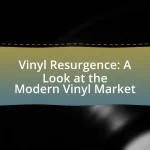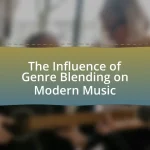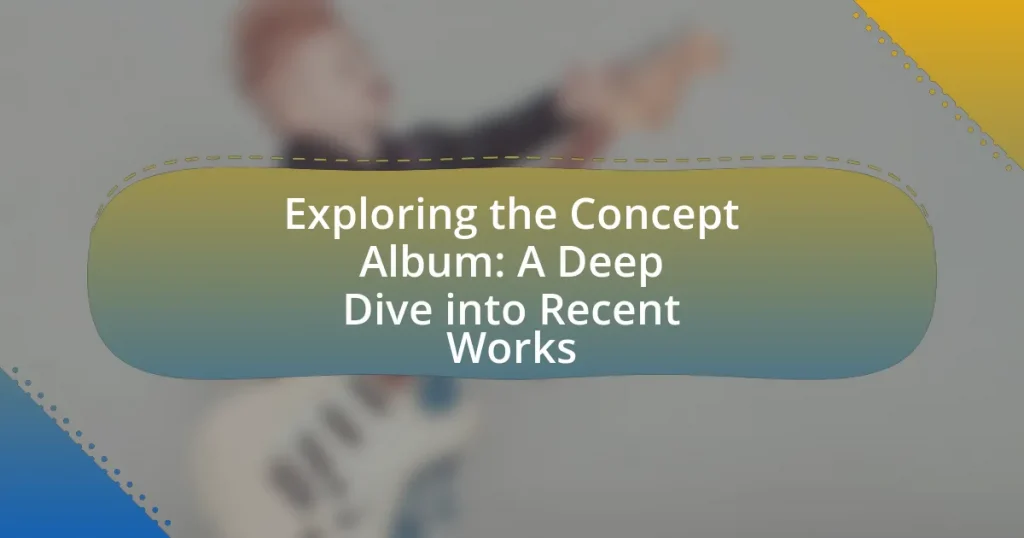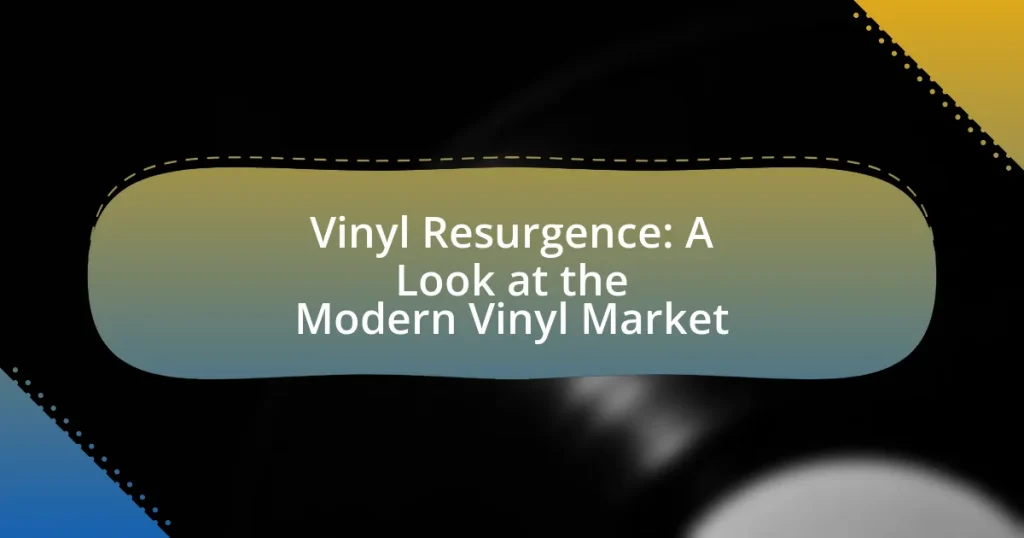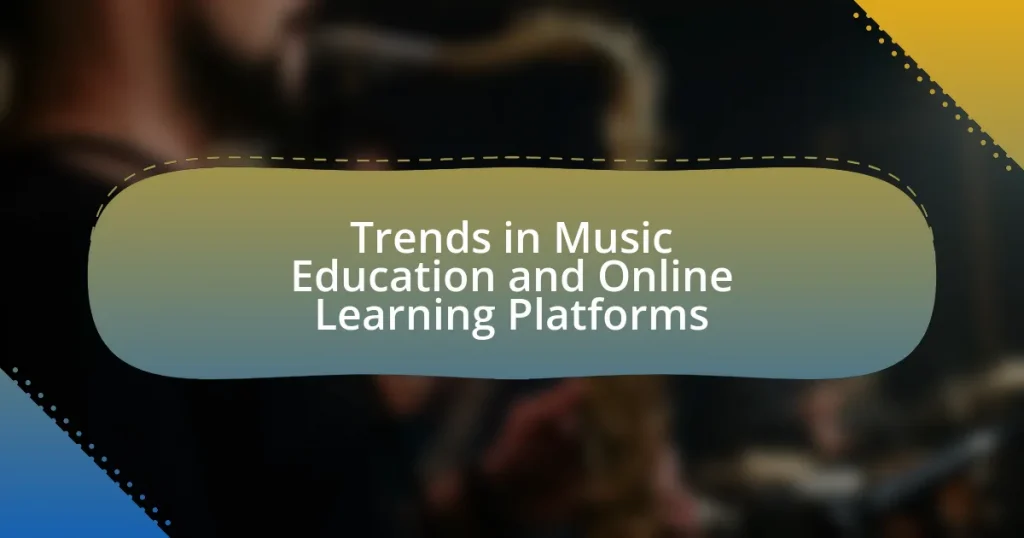The article explores the concept album as a distinct musical format characterized by a unified theme or narrative that connects all tracks. It examines how concept albums differ from traditional albums, highlighting their defining characteristics, common themes, and the narrative elements that enhance the listening experience. The discussion includes notable examples of concept albums, the evolution of the format over time, and the impact of technological advancements on production. Additionally, it addresses the challenges artists face in creating concept albums and outlines best practices for effectively conveying messages through this artistic medium.
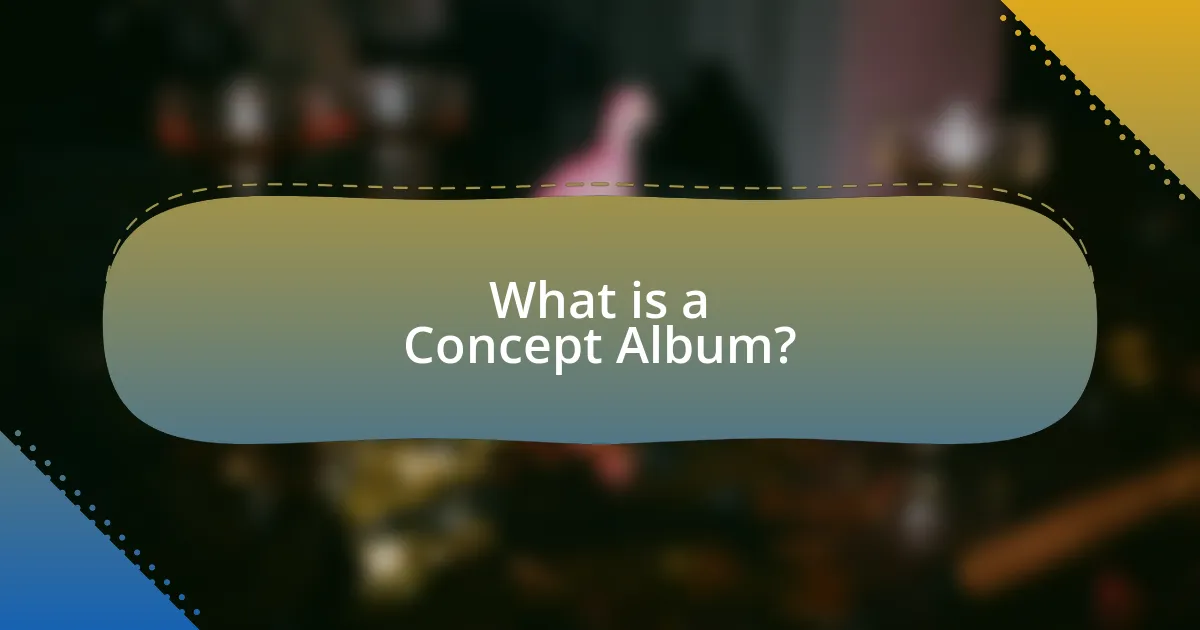
What is a Concept Album?
A concept album is a music album that is unified by a specific theme or narrative, often telling a story or exploring a particular idea throughout its tracks. This format allows artists to create a cohesive listening experience, where each song contributes to the overall concept. Notable examples include Pink Floyd’s “The Wall,” which addresses themes of isolation and alienation, and The Who’s “Tommy,” which tells the story of a deaf, dumb, and blind boy. These albums demonstrate how a central theme can enhance the artistic expression and emotional impact of the music.
How does a concept album differ from a traditional album?
A concept album differs from a traditional album in that it is structured around a central theme or narrative that connects all the songs, whereas a traditional album typically consists of standalone tracks without a cohesive storyline. Concept albums often explore complex ideas or tell a story throughout the entire work, as seen in Pink Floyd’s “The Wall,” which addresses themes of isolation and mental health, creating a unified artistic statement. In contrast, traditional albums, like Taylor Swift’s “1989,” may feature a collection of songs that vary in subject matter and style, lacking an overarching narrative. This distinction highlights the artistic intent behind concept albums to provide a deeper listening experience through thematic continuity.
What are the defining characteristics of a concept album?
A concept album is defined by its cohesive narrative or thematic structure that connects all the songs within it. This characteristic often involves a storyline or a central idea that is explored throughout the album, allowing for a deeper artistic expression. For example, Pink Floyd’s “The Wall” presents a continuous narrative about isolation and personal struggle, illustrating how the songs interrelate to convey a unified message. Additionally, concept albums frequently employ recurring musical motifs or lyrical themes, enhancing the listener’s experience by creating a sense of continuity and progression. This format has been utilized by various artists across genres, reinforcing the concept album’s significance in music history.
Why do artists choose to create concept albums?
Artists choose to create concept albums to convey a cohesive narrative or theme throughout the entire work. This approach allows musicians to explore complex ideas, emotions, or stories in a structured format, enhancing the listener’s experience. For instance, Pink Floyd’s “The Wall” addresses themes of isolation and mental health, illustrating how a unified concept can deepen the impact of the music. Additionally, concept albums often encourage artistic experimentation, enabling artists to push creative boundaries and engage audiences on multiple levels.
What themes are commonly explored in concept albums?
Common themes explored in concept albums include personal journeys, social issues, and fictional narratives. Personal journeys often reflect the artist’s experiences, emotions, and growth, as seen in albums like “The Wall” by Pink Floyd, which delves into isolation and self-discovery. Social issues are frequently addressed, with artists using their platform to comment on politics, inequality, and cultural challenges, exemplified by Kendrick Lamar’s “To Pimp a Butterfly,” which tackles race and identity. Fictional narratives create immersive stories, as demonstrated in “American Idiot” by Green Day, which critiques American society through a fictional lens. These themes provide a cohesive framework that enhances the storytelling aspect of concept albums, making them impactful and resonant with listeners.
How do narrative elements play a role in concept albums?
Narrative elements are crucial in concept albums as they provide a cohesive storyline that connects the individual tracks, creating a unified artistic experience. These elements often include character development, thematic progression, and plot structure, which guide the listener through a specific journey or message. For instance, Pink Floyd’s “The Wall” employs a narrative arc that explores themes of isolation and mental anguish, effectively engaging the audience through its storytelling. This integration of narrative not only enhances emotional resonance but also encourages deeper analysis and interpretation of the music, making the concept album a distinct form of artistic expression.
What are some examples of recurring motifs in recent concept albums?
Recent concept albums frequently explore motifs such as existentialism, personal struggle, and societal critique. For instance, in “The Age of Adz” by Sufjan Stevens, themes of mental health and the human experience are prevalent, reflecting a deep introspection. Similarly, “To Pimp a Butterfly” by Kendrick Lamar addresses racial identity and systemic oppression, showcasing a narrative of resilience and empowerment. These motifs are not only central to the albums’ narratives but also resonate with listeners, providing a framework for understanding complex social issues.
How has the concept album evolved over time?
The concept album has evolved significantly from its origins in the 1960s, where it was primarily characterized by a cohesive narrative or theme across tracks, as seen in works like The Beatles’ “Sgt. Pepper’s Lonely Hearts Club Band.” Over time, artists began to experiment with more complex storytelling and diverse musical styles, leading to landmark albums such as Pink Floyd’s “The Wall” in the 1970s, which integrated rock with theatrical elements. In the 1990s and 2000s, the rise of digital technology allowed for innovative approaches to concept albums, enabling artists like Radiohead in “OK Computer” to blend genres and incorporate multimedia elements. Today, contemporary artists such as Kendrick Lamar in “To Pimp a Butterfly” utilize the concept album format to address social issues, showcasing the evolution towards deeper thematic exploration and cultural commentary. This progression highlights the concept album’s adaptability and relevance in reflecting societal changes and artistic innovation.
What historical milestones have shaped the concept album format?
The concept album format has been shaped by several historical milestones, including the release of “Sgt. Pepper’s Lonely Hearts Club Band” by The Beatles in 1967, which is often credited with popularizing the format by presenting a cohesive narrative and thematic unity across its tracks. Additionally, Pink Floyd’s “The Dark Side of the Moon,” released in 1973, further solidified the concept album’s significance in rock music by integrating complex themes and innovative production techniques. Another key milestone was the emergence of progressive rock in the late 1960s and 1970s, with bands like Yes and Genesis creating albums that told stories or explored intricate musical ideas over extended compositions. These milestones collectively established the concept album as a respected and influential format in the music industry.
How have technological advancements influenced concept album production?
Technological advancements have significantly influenced concept album production by enabling more sophisticated recording techniques and enhancing creative possibilities. Digital audio workstations (DAWs) allow artists to manipulate sound with precision, facilitating complex arrangements and seamless transitions between tracks, which are essential for narrative cohesion in concept albums. Additionally, advancements in music distribution, such as streaming platforms, have changed how concept albums are consumed, allowing for broader reach and immediate feedback from audiences. For instance, the use of high-definition audio formats and immersive sound technologies, like Dolby Atmos, has elevated the listening experience, making it more engaging and reflective of the album’s thematic depth.
What are some notable recent concept albums?
Notable recent concept albums include “The Age of Adz” by Sufjan Stevens, released in 2010, which explores themes of love and mental illness through a blend of orchestral and electronic music. Another significant album is “To Pimp a Butterfly” by Kendrick Lamar, released in 2015, addressing racial inequality and personal struggles within a cohesive narrative. Additionally, “The Last Shadow Puppets” released “Everything You’ve Come to Expect” in 2016, which weaves together stories of love and loss. These albums are recognized for their intricate storytelling and thematic depth, contributing to the evolution of the concept album format in contemporary music.
How do these albums reflect contemporary societal issues?
These albums reflect contemporary societal issues by addressing themes such as inequality, mental health, and political unrest. For instance, many artists incorporate personal narratives that highlight systemic injustices, such as racial discrimination and economic disparity, which resonate with current movements like Black Lives Matter and climate activism. Additionally, the exploration of mental health in lyrics mirrors the growing public discourse around mental wellness, as seen in statistics indicating that one in five adults experience mental illness in a given year. This alignment with societal concerns not only fosters awareness but also encourages listeners to engage with these pressing issues.
What innovative techniques are used in these recent works?
Recent works in concept albums utilize innovative techniques such as narrative storytelling, multimedia integration, and genre-blending. Narrative storytelling allows artists to create cohesive themes and character arcs throughout the album, enhancing listener engagement. For example, the album “The Age of Adz” by Sufjan Stevens employs a narrative structure that unfolds over its tracks, creating a compelling emotional journey. Multimedia integration involves the use of visual elements, such as music videos and interactive websites, to complement the auditory experience, as seen in the album “Lemonade” by Beyoncé, which combines music with powerful visual storytelling. Genre-blending techniques, where artists mix various musical styles, are exemplified in the album “To Pimp a Butterfly” by Kendrick Lamar, which fuses hip-hop with jazz, funk, and spoken word, pushing the boundaries of traditional genre classifications. These techniques collectively enhance the artistic expression and depth of concept albums, making them more immersive and impactful for audiences.
How do artists approach the creation of a concept album?
Artists approach the creation of a concept album by first establishing a central theme or narrative that guides the entire work. This thematic foundation often involves storytelling elements, character development, or a specific emotional journey that the artist wishes to convey. For instance, Pink Floyd’s “The Wall” explores themes of isolation and personal struggle, illustrating how a cohesive narrative can enhance the listening experience.
Additionally, artists typically outline the album’s structure, determining how each track contributes to the overarching concept. This may involve careful sequencing of songs to create a flow that mirrors the narrative arc. The Beatles’ “Sgt. Pepper’s Lonely Hearts Club Band” exemplifies this approach, as each song connects to the album’s fictional band concept, creating a unified artistic statement.
Moreover, artists often incorporate recurring motifs, lyrical references, or musical themes throughout the album to reinforce the concept. This technique not only deepens the listener’s engagement but also creates a richer, more immersive experience. For example, David Bowie’s “The Rise and Fall of Ziggy Stardust and the Spiders from Mars” uses recurring characters and themes to weave a complex narrative that resonates with audiences.
In summary, artists methodically develop a concept album by defining a central theme, structuring the album cohesively, and employing recurring elements to enhance the narrative, as evidenced by notable works in music history.
What is the typical songwriting process for a concept album?
The typical songwriting process for a concept album involves several key stages: conceptualization, thematic development, composition, and arrangement. Initially, artists define a central theme or narrative that will guide the entire album, often inspired by literature, personal experiences, or social issues. Following this, songwriters develop the thematic elements, ensuring that each track contributes to the overarching story or concept.
During composition, musicians create melodies, harmonies, and lyrics that align with the established theme, often experimenting with different musical styles to enhance the narrative. Finally, the arrangement stage involves structuring the songs in a way that maintains flow and coherence, ensuring that transitions between tracks support the overall concept. This process is evident in notable concept albums like Pink Floyd’s “The Wall,” where each song intricately ties into the album’s narrative arc.
How do artists integrate visual elements with their concept albums?
Artists integrate visual elements with their concept albums by creating cohesive artwork, music videos, and live performances that reflect the themes and narratives of the album. For instance, album covers often feature imagery that symbolizes the overarching story or emotional journey, enhancing the listener’s experience. Additionally, music videos serve as a visual extension of the album’s narrative, providing context and deeper understanding of the songs. Live performances frequently incorporate visual elements such as stage design, lighting, and projections that align with the album’s concept, further immersing the audience in the artistic vision. This integration is evident in works like Pink Floyd’s “The Wall,” where visuals play a crucial role in conveying the album’s themes of isolation and societal critique.
What impact do concept albums have on listeners?
Concept albums significantly enhance listeners’ emotional engagement and cognitive processing of music. By presenting a cohesive narrative or thematic structure, concept albums encourage deeper reflection and connection to the material, often leading to a more immersive listening experience. Research indicates that albums like Pink Floyd’s “The Wall” and Kendrick Lamar’s “To Pimp a Butterfly” not only tell stories but also evoke strong emotional responses, fostering a sense of empathy and understanding among listeners. This narrative-driven approach can lead to increased retention of the music and its themes, as listeners are more likely to remember and relate to the overarching message conveyed throughout the album.
How do concept albums enhance the listening experience?
Concept albums enhance the listening experience by providing a cohesive narrative or thematic structure that engages listeners on a deeper level. This format allows artists to explore complex ideas and emotions throughout the album, creating a more immersive experience compared to traditional albums with standalone tracks. For instance, Pink Floyd’s “The Wall” intricately weaves a story about isolation and alienation, encouraging listeners to engage with the music as a unified whole rather than as individual songs. This narrative approach fosters emotional connections and encourages repeated listens, as audiences discover new layers and meanings with each play.
What emotional responses do concept albums evoke in audiences?
Concept albums evoke a range of emotional responses in audiences, including nostalgia, empathy, and introspection. These albums often tell a cohesive story or explore a central theme, which allows listeners to connect deeply with the narrative and characters presented. For instance, Pink Floyd’s “The Wall” elicits feelings of alienation and despair through its exploration of personal trauma and societal issues. Similarly, Kendrick Lamar’s “good kid, m.A.A.d city” evokes empathy and reflection on the struggles of growing up in a challenging environment. The structured storytelling and thematic depth of concept albums engage listeners on an emotional level, prompting them to reflect on their own experiences and feelings.
What are the challenges of producing a concept album?
Producing a concept album presents several challenges, including maintaining a cohesive narrative throughout the tracks, balancing artistic vision with commercial viability, and ensuring that each song contributes meaningfully to the overall theme. Cohesion is critical, as a disjointed narrative can confuse listeners and dilute the intended message. Additionally, artists often face pressure to create commercially successful music, which can conflict with their creative ambitions. For instance, the 2016 album “The Life of Pablo” by Kanye West illustrates this struggle, as it blends personal storytelling with mainstream appeal, showcasing the difficulty of merging artistic integrity with market demands. Furthermore, the production process itself can be complex, requiring collaboration among various musicians and producers to achieve a unified sound that aligns with the concept.
How do artists overcome creative blocks during the process?
Artists overcome creative blocks during the process by employing various techniques such as changing their environment, setting specific goals, and engaging in different creative activities. For instance, altering their workspace can stimulate new ideas and perspectives, while setting achievable milestones helps maintain focus and motivation. Engaging in unrelated creative pursuits, like drawing or writing, can also provide fresh inspiration and break the monotony. Research indicates that these strategies can effectively reduce anxiety and enhance creativity, as demonstrated in studies on creative problem-solving and cognitive flexibility.
What are the risks associated with concept albums in the music industry?
Concept albums in the music industry carry several risks, including limited commercial appeal, potential alienation of listeners, and increased production costs. Limited commercial appeal arises because concept albums often prioritize artistic expression over mainstream accessibility, which can lead to lower sales compared to more conventional albums. Additionally, the intricate narratives or themes may alienate casual listeners who prefer standalone tracks, resulting in a narrower audience. Increased production costs are also a significant risk, as creating a cohesive concept album often requires more time, resources, and collaboration, which may not yield a proportional return on investment. These factors collectively contribute to the challenges faced by artists and labels when producing concept albums.
What are best practices for creating a successful concept album?
To create a successful concept album, artists should focus on a cohesive narrative that connects all tracks, ensuring thematic consistency throughout the project. This involves developing a clear storyline or concept that resonates with listeners, allowing them to engage deeply with the music. Additionally, artists should consider the arrangement and flow of the album, as transitions between songs can enhance the storytelling experience.
Incorporating diverse musical elements and styles can also keep the listener’s interest while still aligning with the overarching theme. Collaborating with other musicians or producers can bring fresh perspectives and ideas, enriching the final product.
Successful concept albums, such as Pink Floyd’s “The Wall” and The Who’s “Tommy,” exemplify these practices by integrating narrative depth with musical innovation, demonstrating that a well-executed concept can elevate an album’s impact and reception.
How can artists effectively convey their message through a concept album?
Artists can effectively convey their message through a concept album by creating a cohesive narrative that integrates lyrics, music, and thematic elements. This approach allows for a deeper exploration of ideas, emotions, and stories, engaging listeners on multiple levels. For instance, Pink Floyd’s “The Wall” illustrates this by using a storyline that addresses themes of isolation and mental health, supported by both lyrical content and musical transitions that enhance the overall experience. By carefully structuring songs to reflect different parts of the narrative, artists can guide listeners through an emotional journey, making the message more impactful and memorable.
What strategies can be employed to engage listeners with a concept album?
To engage listeners with a concept album, artists can employ storytelling techniques that create a narrative arc throughout the album. This strategy allows listeners to connect emotionally with the themes and characters presented in the music. For instance, Pink Floyd’s “The Wall” effectively uses a cohesive storyline to explore complex themes of isolation and alienation, which enhances listener engagement. Additionally, incorporating multimedia elements such as visuals, music videos, and live performances can further immerse the audience in the album’s concept, as seen in Beyoncé’s “Lemonade,” which combines music with powerful imagery to deepen the narrative experience.

